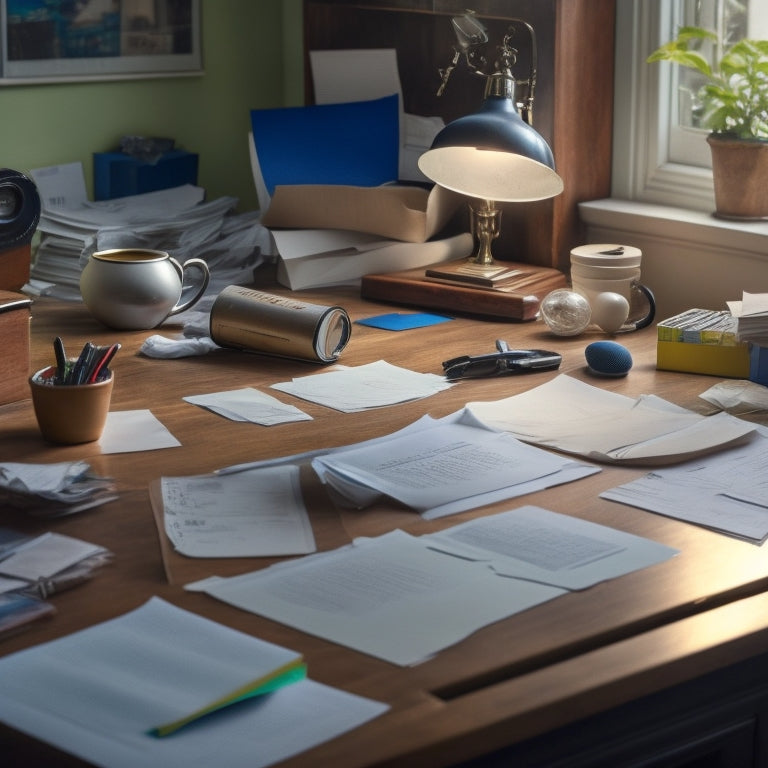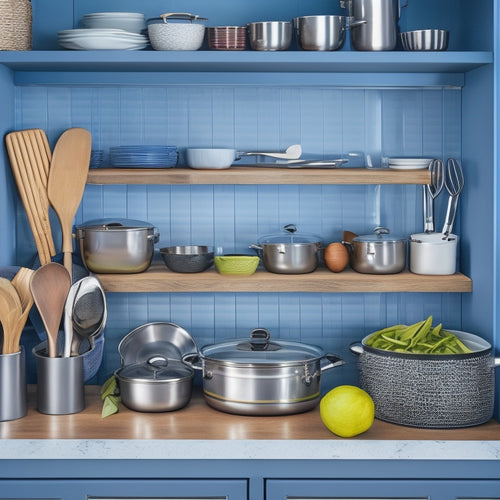
What's the Best System for Paper Clutter
Share
You're likely drowning in a sea of paperwork, and it's time to take control of the chaos. To create a customized system that works for you, start by identifying the types of papers that contribute to your clutter, and develop a strategy that combines physical and digital organizational tools. Consider popular methods like digital organization, minimalist approaches, and filing techniques to find what suits your personality and work style. By integrating these components and scheduling regular maintenance, you'll be able to contain clutter and gain control over your papers. Now, investigate how to fine-tune your system to achieve long-term organization success.
Key Takeaways
- A customized paper management system combines various methods to suit your personality, work style, and available space for optimal efficiency.
- Identifying frequent paper types and understanding root causes of clutter help develop effective organization strategies.
- A designated "paper station" or workspace, along with categorized folders and standardized naming conventions, enhances organization and accessibility.
- Integrating physical and digital storage methods, such as file folders and cloud storage, maximizes efficiency and reduces clutter.
- Regular maintenance, including weekly system review and updates, is crucial for maintaining a clutter-free space and ensuring long-term organization success.
Understanding Paper Clutter Chaos
How does a simple piece of paper, something so thin and lightweight, manage to wreak such havoc on our lives and spaces? You're not alone in struggling to tame the paper beast. Different paper types, from receipts to reports, can quickly overwhelm your space and mind.
Effective digital file management strategies, such as establishing a logical file structure, can also be applied to paper clutter. By implementing categorized folders and standardized naming conventions, you can better organize your paper documents.
The key to regaining control lies in understanding the root of the chaos. Identify the types of paper that frequently clutter your space, and categorize them accordingly. This will help you develop effective organization strategies customized to your specific needs.
Essential Components of a System
Now that you've identified the types of paper that frequently clutter your space and categorized them accordingly, you're ready to build a system that keeps them under control.
A solid system consists of essential components that work together to maintain order. First, you'll need organizational tools like file folders, labels, and storage bins to categorize and store physical documents.
Consider digital alternatives like cloud storage or apps to reduce paper clutter and increase accessibility. A designated workspace or "paper station" will help contain the clutter and provide a dedicated area for processing paperwork.
Popular Paper Management Methods
Within the structure of your paper management system, incorporating a tried-and-true method can make all the difference in maintaining organization and reducing clutter.
You'll want to take into account methods that fit your personality, work style, and available space.
-
Digital Organization: Implement a digital system, such as cloud storage or apps, to store and access important documents, reducing physical clutter.
-
Minimalist Approach: Adopt a "less is more" mindset, regularly purging unnecessary papers and focusing on essential documents.
-
Filing Techniques: Develop a logical filing system, using clear labels and categories, to facilitate easy retrieval of documents.
- Decluttering Strategies: Establish a regular routine for sorting, categorizing, and disposing of unnecessary papers, keeping your space organized and clutter-free.
These methods will assist you in regaining control over your paper clutter and creating a more organized, stress-free environment.
Creating a Customized Solution
Combine the methods that connect with you to craft a customized system that addresses your unique paper clutter challenges.
You've learned about popular paper management methods, now it's time to personalize them to fit your needs. Identify the strengths of each approach and merge them to create a personalized strategy that works for you.
Consider your lifestyle, habits, and priorities to develop a personalized organization system that you'll actually use. Don't be afraid to experiment and adjust your approach as needed.
With a customized solution, you'll be more efficient, productive, and in control of your paper clutter. By embracing your individuality, you'll create a system that truly supports your goals and preferences.
Maintaining Your Paper Clutter System
Your customized system for managing paper clutter is in place, and you're enjoying the sense of control and productivity it brings.
Now, it's crucial to maintain your system to guarantee it continues to serve you well.
To keep your paper organization running smoothly, follow these decluttering strategies:
-
Schedule regular maintenance: Set aside time each week to review and update your system.
-
Purge unnecessary documents: Get rid of papers that are outdated, irrelevant, or no longer needed.
-
Re-file and re-organize: Make certain papers are filed correctly and easily accessible.
- Review and adjust: Periodically assess your system's effectiveness and make changes as needed.
Frequently Asked Questions
How Do I Handle Paper Clutter From Prior Years or Decades?
You're not alone: 80% of papers kept are never looked at again! To tackle past paperwork disposal, sort items into shred, digitize, and sentimental document retention boxes, then prioritize digitizing important docs and letting go of the rest.
Can I Digitize Sensitive Documents Like Passports and Social Security Cards?
You're wise to contemplate digitizing sensitive documents like passports and social security cards, but prioritize digital security by using reputable services with strong document encryption to safeguard your most private information.
Are Paper Trays and Baskets Worth the Investment for Organization?
As you tackle paper chaos, ask yourself: do paper trays and baskets really bring order? The answer lies in their ability to provide accessible storage solutions, streamlining your paper organization and giving you the control you crave.
How Often Should I Review and Update My Paper Clutter System?
You should review your paper clutter system every 3-6 months to guarantee it's working for you, and update strategies as needed; consider seasonal adjustments, like post-tax season or back-to-school, to maintain control and optimize organization.
Can a Paper Clutter System Be Adapted for Multiple Family Members?
Just as a conductor expertly leads an orchestra, you can harmonize your family's paper clutter system by assigning shared responsibilities, encouraging family involvement, and adapting your system to accommodate each member's needs, resulting in a concert of organization and efficiency.
Related Posts
-

Maximizing Garage Storage
Maximize Your Garage Storage: A Comprehensive Guide Welcome to the ultimate guide to maximizing your garage storag...
-

Maximize Space With These Top Organization Apps
You're just a few clicks away from maximizing your space and time! Start by decluttering your digital life, then opti...
-

Why Opt for Cabinet Drawer Organizers?
By opting for cabinet drawer organizers, you'll reveal more storage space, reduce kitchen clutter stress, and enhance...


